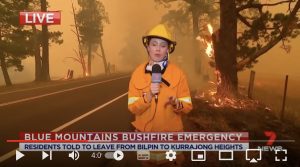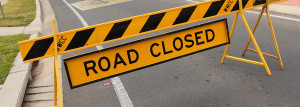Do not underestimate the importance of contingency plans – your future self will thank you!
The dreaded ‘What ifs’:
But I’m never home on Tuesdays…
But we are minding the nephew on Saturday…
The car is at the mechanics until Thursday…
The fire is already at my back door…
There are some things we have absolutely no control over, so our best chance is to make contingency plans to prepare for every day circumstances that affect our emergency plans. Every household is unique – including location and situation. Bearing that in mind, we want you to be aware of what you can do in a bushfire emergency. We call it Plan B, but you might need a plan C, D and maybe E too.
 Video: 21 December 2019
Video: 21 December 2019
The Great Western Highway closed in both directions. Residents in the Lithgow area escape their burning homes. Bilpin residents have already evacuated as the fire jumped the Bells Line of Road. Six emergency level warnings already given with a seventh one likely. It was too late for people to leave the Blue Mountains, and this was not the first time
If you’d like a sobering reminder of why planning is important, watch this video of an horrific day, 21 December 2019 »
Activity:
5 things to consider for your Plan B
While you read through the rest of this article we ask you to answer the question, What is different today? What would you do on days of an Extreme Fire Danger Rating and different Alert Levels? These things can be triggers that can spur you into action based on what’s happening in your household today, because you planned for it!
To complete this activity, you will need to draw up a mud map of your surrounding area including places you are considering evacuating to. Printing a map off from google maps is fine and a great place to start.
Download the ScenarioGrid: This is a simple Word document that will help you plan for different scenarios in your household. Make it your own! We’d love to see what you come up with. If computers are not really your friend, try this exercise on a white board or large sheet of paper.
Remember, whatever you decide to do, it is important to talk about your plans with your family so everyone in the house knows what to do.
Consider these five things and how they can change your plans
1. Transport and Evacuation
Does everyone have transport and are your planned routes safe?
In week 1 of the Six Week Challenge we looked at safest routes and safer places. Remind yourself of your alternatives and mark them on your Mud Map. Where are you going and how are you getting there?
During an emergency refer to these sites to find out if roads and transport in your area are being affected by bushfire conditions or traffic jams before you head out:
Live Traffic updates
Public Transport Info NSW
2. Planning for Leaving
If you are leaving early, does that mean you are taking Nan and the the cats to Aunty Jo’s in Lithgow?
If your plan involves traveling the highway, consider leaving hours before fire threatens your area or anywhere that may cross your journey. The Great Western Highway is quickly clogged with traffic and is met on both sides by dense bushland that could be impacted by fire, and thick smoke. This occurred on 21 December 2019 when fires impacted the town of Bilpin and the highway was closed both ways.
Mark on your Mud Map two more places you could go if the highway is closed or under threat.
The safest place to be is away from fire impacted areas. That means if the conditions are extreme or catastrophic or if you are not fit and prepared to defend your property, or you need to look after someone else – get out before your area is impacted by fire.
Go to the shops, go to a friend’s house. Don’t put yourself in harm’s way by waiting to see what happens.
Do you live in a long leafy dead end street? Look for a place to go if your street is cut off by fire. Usually this is a well prepared house, with a good clearing around it. A large clear open area with short grass, bitumen or concrete or an already burnt area will give you some protection.
Do you have school aged kids? Stay up to date with your school’s evacuation policies and locations. These can change. If you need to pick them up, make sure the route is safe before you leave. Find out if your school has a lock down procedure in the event of bushfire or other natural disaster.
Remember, leaving too late puts you at the most risk – leaving early is your safest option. Driving through smoke reduces visibility putting you, other motorists and emergency services at risk of collision or possibly in the path of a fire.
Leaving early could mean leaving before 10AM – fire weather is usually more benign at night or early in the morning. Mark on your Mud Map at least two places you could evacuate to safely and stay for 24 hours or more if needed.
Rehearse your plan, get out and give it a go. Practice packing everyone up and make sure you all fit!
3. Planning for Staying or when it’s “too late to leave”
“It is not safe to do nothing” goes the saying. Seek shelter from radiant heat and flames; look out for fires starting around you and put them out while they are still small. The best defence is offence. (This is really why you have a cotton mop. It’s not just for the bathroom floor!)
It’s definitely too late to get the mower out now. Instead, bring in garden furniture, door mats, and clear access paths around your home.
If you can, fill bins and large buckets sinks and bathtubs with water for easy access to blot out spot fires around your property, do the same with tubs inside the house. Wet cotton mops and towels are the most efficient tools to conserve your water supply.
If you don’t have gutter guards installed – block your gutter pipes and fill the gutters with water to prevent embers settling in them.
Roll up towels and cover the gap under the door to keep smoke out of your shelter.
As the fire front arrives seek shelter inside a well-prepared house, look for exits in each room. Is there more than one way out – ground level windows or doors?
A solid defendable structure will protect you from the intensity of the fire front. Don’t stay in a burning building; once the main front passes it will be safer outside. Patrol your area and extinguish small spot fires before they take hold. Assess your condition and seek medical treatment of you are injured. Take care of your wellbeing, hydrate and rest.
Protect yourself against radiant heat and falling embers with wool blankets from your Emergency Box.
Mark on your Mud Map places you could go if you are told, “It’s too late to leave, shelter in place.”
- Identify nearby structures that are well prepared and defendable
- Identify large clear areas that have nothing to burn like roads or large yards and parks with short grass. Areas that have already been burnt can also provide relative safety.
- Mark Neighbourhood Safer Places on your Mud Map, understand that these are places of last resort and do not offer much protection from the elements but may be used as a temporary safety refuge when no other shelter is deemed safe and defendable. They are not evacuation centres.
4. Get your defender tools ready, just in case
Staying to defend your home or too late to leave, here is your list of essentials to protect yourself and assist with recovery after the fire passes.
- Cotton Hairy Mop
- Metal buckets, tubs and bins
- Spare hose on a hook or roll, enough to reach around your home (you will need to bring it inside while the fire front passes through)
- Ladder
- Metal rake and shovel
- Protective Clothing
- Lots of drinking water (about 3L per person, per day) and healthy snacks like trail mix or muesli bars
- Phone and backup battery. Keep looking for updates and let people know how you are going. This could be your life line if things go wrong.
- Large water supply with petrol pump as part of a sprinkler system if possible. You may also pump direct from a tank, pool or dam. You cannot rely on mains water pressure during emergencies.
Nothing is more important than your safety. Look after yourself.
5. Staying connected
Try to get Apps on your phone as well for updates on the go – but don’t rely completely on them because during emergencies phone networks can become congested and crash. Keep your phone charged, have rechargeable battery packs charged and ready and, make sure you let people know you are OK. Be patient.
Stay alert, monitor your surroundings and be aware of changes and possible threats and risks.
Talk to your neighbours and family, open up the channels of communication to make sure you will all be safer and feel connected no matter what the emergency brings.
Have you ever heard these common quotes?
“My plan is to wait and see”
“I didn’t think it could happen to me.”
The more you have done to prepare, the easier it will be for you to plan and implement your alternatives. Practicing and adapting your plans can get them pretty close to perfect.
People who do not prepare because they do not personalise their risk will take longer to recover from a major incident. We don’t want you to become a statistic of loss. Prepare now.

